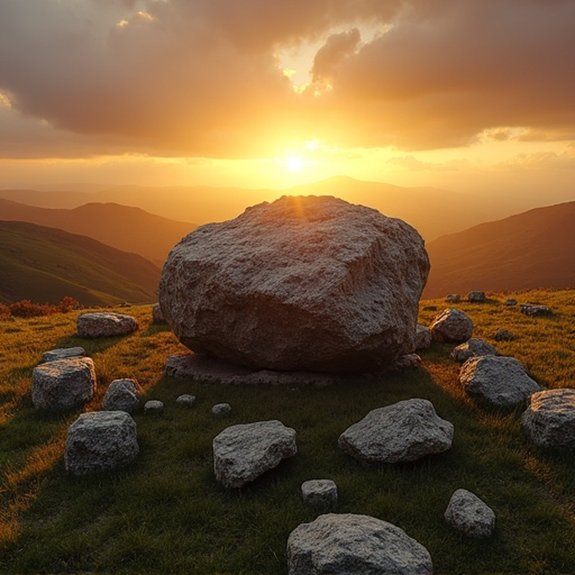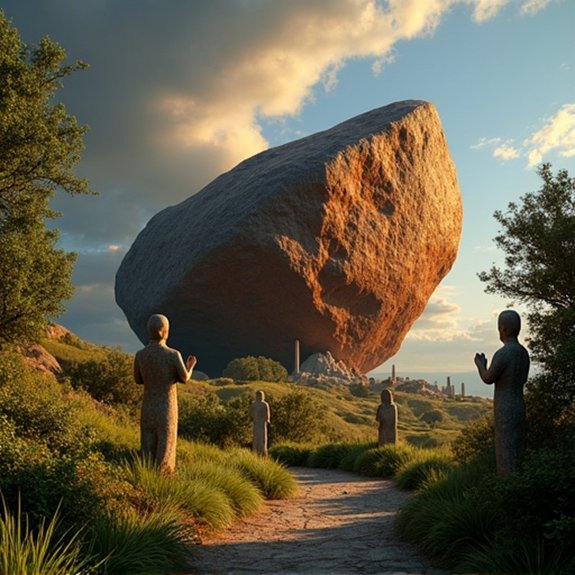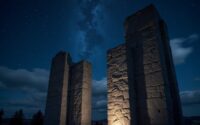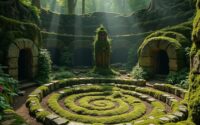The Hoba Meteorite and Ancient Worship
The world’s largest known meteorite has rested in Namibian soil for 80,000 years, yet Western science didn’t acknowledge its existence until 1920. The Hoba meteorite‘s massive iron-nickel form attracted centuries of indigenous reverence before any farmer’s plow struck its surface. What drove ancient peoples to worship this 66-ton celestial visitor? The answer lies in a complex web of spiritual beliefs that modern archaeology is only beginning to unravel.
Introduction

When ancient peoples first encountered the Hoba meteorite in what’s now Namibia, they’d have witnessed the largest known meteorite on Earth—a 60-ton mass of iron that fell from space roughly 80,000 years ago. The meteorite’s flat-topped surface spans nearly three meters across, creating a natural altar-like platform. Archaeological evidence suggests various groups regarded this celestial object with reverence over millennia. The San people, the region’s earliest inhabitants, likely discovered it first and incorporated it into their spiritual practices. Later arrivals, including Bantu-speaking peoples, continued this tradition of veneration. The meteorite’s unusual composition—84% iron and 16% nickel—produces a distinctive metallic sheen that ancient observers would’ve found otherworldly. Its immovable presence and extraterrestrial origin made it a focal point for ritual activities and cosmological beliefs.
Discovery in 1920 Namibia
Despite millennia of indigenous knowledge about the meteorite, Western science didn’t recognize its existence until a chance discovery in 1920. Farmer Jacobus Hermanus Brits found the massive iron object while plowing his field on Hoba West Farm near Grootfontein, Namibia. His ox-drawn plow struck the metallic surface, producing an unusual scraping sound that prompted investigation.
Brits excavated around the object, revealing an enormous mass that wouldn’t budge. He’d uncovered what scientists would later confirm as Earth’s largest known meteorite, weighing approximately 60 tons. The flat-topped iron mass measured roughly three meters across and one meter thick. Local Nama people had long known about the rock, calling it “hoba,” meaning “gift.” British geologist Leigh Parrington first scientifically documented the meteorite’s composition and extraterrestrial origin shortly after Brits reported his discovery.
Notable Cases or Sightings

Records from ancient civilizations suggest the Hoba meteorite wasn’t the only cosmic visitor to capture human attention throughout history. The Black Stone of Mecca, embedded in the Kaaba’s eastern corner, has drawn millions of pilgrims since pre-Islamic times. Many scholars believe it’s meteoritic in origin.
In 1492, witnesses in Ensisheim, France, watched a 280-pound stone fall from the sky. The meteorite became Europe’s oldest preserved witnessed fall, with Emperor Maximilian declaring it a divine sign. Japan’s Nogata meteorite, which fell in 861 CE, sparked the construction of a Shinto shrine where it’s still venerated today.
Aboriginal Australians incorporated the Henbury meteorite craters into their oral traditions 4,700 years ago, calling the site “sun walk fire devil rock.” These cases demonstrate humanity’s consistent fascination with celestial objects across cultures and millennia.
Common Theories or Explanations
The reverence ancient peoples showed toward meteorites like Hoba stems from several interconnected beliefs about their supernatural origins. Many cultures interpreted these fallen objects as divine messages or gifts from sky deities. The meteorites’ extraterrestrial nature and dramatic arrival through fiery descent reinforced beliefs they’d originated in celestial domains where gods resided.
Their unusual metallic composition, unlike any earthly stones, further convinced ancient observers of their sacred properties. Some societies believed meteorites contained souls of departed ancestors returning to Earth. Others thought they possessed healing powers or could guarantee agricultural fertility. The objects’ durability and resistance to weathering suggested they’d been forged by supernatural forces. These interpretations weren’t isolated; similar beliefs emerged independently across continents, indicating humanity’s universal tendency to assign spiritual significance to mysterious cosmic phenomena.
Frequently Asked Questions
Can Visitors Touch the Hoba Meteorite Today?
Yes, visitors can touch the Hoba meteorite today. They’re allowed to climb on it and take photographs. The meteorite’s located on a farm in Namibia where tourists regularly visit and physically interact with it.
What Preservation Methods Protect the Meteorite From Weathering?
Scientists apply protective coatings and rust inhibitors to the meteorite’s surface. They’ve installed drainage systems to prevent water accumulation, and security fencing limits human contact. Regular maintenance removes debris and monitors the iron’s oxidation rate.
Are There Any Local Legends About the Meteorite’s Powers?
Local Nama people haven’t documented specific legends about the meteorite’s powers. They’ve known about it for generations before its 1920 scientific discovery, but researchers haven’t found evidence of supernatural beliefs or ritualistic practices surrounding Hoba.
How Much Does Visiting the Hoba Meteorite Site Cost?
Visitors pay approximately 60 Namibian dollars (about $3-4 USD) to see the Hoba meteorite near Grootfontein. The site’s maintained by local authorities who’ve added walkways, information panels, and basic facilities for tourists exploring this attraction.
What Minerals and Metals Compose the Hoba Meteorite?
The Hoba meteorite’s primarily composed of iron (84%) and nickel (16%), with trace amounts of cobalt, phosphorus, carbon, sulfur, chromium, and copper. It’s classified as an ataxite, a rare type of iron meteorite.


